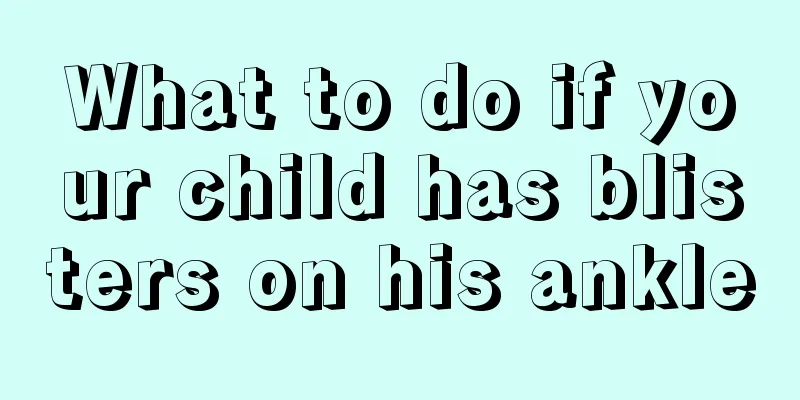What to do if your child has blisters on his ankle

|
If blisters appear on the child's ankle, parents should be vigilant at this time, as it may be caused by athlete's foot. We know that athlete's foot is also a common skin disease caused by fungal infection. It is highly contagious and can be transmitted through some daily necessities. If a child has athlete's foot, he should be treated with medication in time and pay attention to conditioning. What to do if your child has blisters on his ankle 1. Avoid wet feet. Keeping your feet clean and dry is the prerequisite for preventing athlete's foot. Patients with athlete's foot should wear breathable shoes and socks in the summer, and should not wear rubber shoes or sports shoes, let alone wear non-breathable shoes barefoot; after taking a shower and drying your body, be sure not to neglect your feet; do not walk barefoot on carpets or in bathrooms. 2. Avoid alkaline substances. When washing your feet, avoid using irritating chemicals such as alkaline soaps. People with tight spaces between toes can use toilet paper to absorb moisture, allow ventilation, and keep their toes clean. 3. Avoid spicy food. Avoid eating foods that can easily induce sweating, such as hot peppers, raw onions, and raw garlic. It is best not to drink alcohol. Eat more nutritious and easily digestible foods, and eat more vegetables and fruits that are high in vitamins. 4. Avoid sharing cleaning supplies. Avoid using public towels, slippers, etc. in public places such as swimming pools and bathrooms. Shower after swimming and dry with a clean towel. Do not share shoes and socks with others to avoid reinfection. Note: 1. Pay attention to cleanliness, keep your skin dry, keep your feet clean, wash them several times a day, and change your socks frequently. 2. The foot basin and foot towel should be used separately to avoid infecting others. 3. It is not advisable to wear non-breathable shoes such as sports shoes and hiking shoes to avoid excessive foot sweating and aggravated foot odor. People with tight spaces between toes can use some straw paper to sandwich the toes or choose split-toe socks to absorb moisture and allow ventilation. 4. Actively eliminate the triggering factors, such as foot sweat, athlete's foot, etc. Do not eat foods that can easily induce sweating, such as hot peppers, raw onions, raw garlic, etc. 5. Keep a calm mind. Excitement can easily lead to excessive sweating and aggravate athlete's foot. 6. Athlete's foot is a contagious skin disease. You should avoid scratching to prevent self-infection and infection. 7. While using medication for treatment, the shoes and socks worn by the patient must be disinfected. You can expose them to sunlight or wash them in boiling water. It is best to dip a cloth in 10% formalin solution and stuff it into the shoes. Then put them in a plastic bag and seal them for 48 hours to achieve the purpose of sterilization. 8. Some people think that tinea pedis and tinea manuum are health-preserving diseases and that if they are cured they will lead to other diseases. In fact, this is not the case in medicine. Some people lose confidence due to repeated infections, so it is also extremely important to use separate towels, basins, slippers, etc. |
<<: What is the reason for the doll's nose bleeding?
>>: Why does my baby always squint his eyes?
Recommend
How to treat gastritis in children
As people's living standards and quality of l...
2 months old baby milk powder
After the baby is born, as the baby's age inc...
What to do if a two-month-old child has nasal mucus and what to do about it
Many newborns have nasal mucus. The problem of na...
What is the reason for a child's continuous fever?
Children often have fevers during their growth pr...
Will babies get angry if they drink milk?
We all know that milk is rich in nutritional valu...
What to do if your child has phlegm and cough
What should I do if my child has a cough with phl...
What causes stomach pain in children?
When it comes to stomachache, most people may thi...
What to do if your child has a fever, diarrhea and vomiting
Children have very limited resistance. During the...
What are the effects of anemia in infants?
There are not many symptoms of anemia in the earl...
Benefits of enema in children
As parents, we fear our children catching a cold ...
What to do if a child has a high fever and diarrhea? Nursing is the key
If a child has diarrhea and fever, it means that ...
How to treat tooth decay in children?
Many children like to eat sweet foods, especially...
What should I do if my child always has diarrhea?
Diarrhea is a very common disease in children dur...
Why does my baby have a fever? The reason is so complicated
Babies are very prone to high fevers, and the rea...
How to cook goose eggs for babies
Goose eggs are a kind of food suitable for many p...









